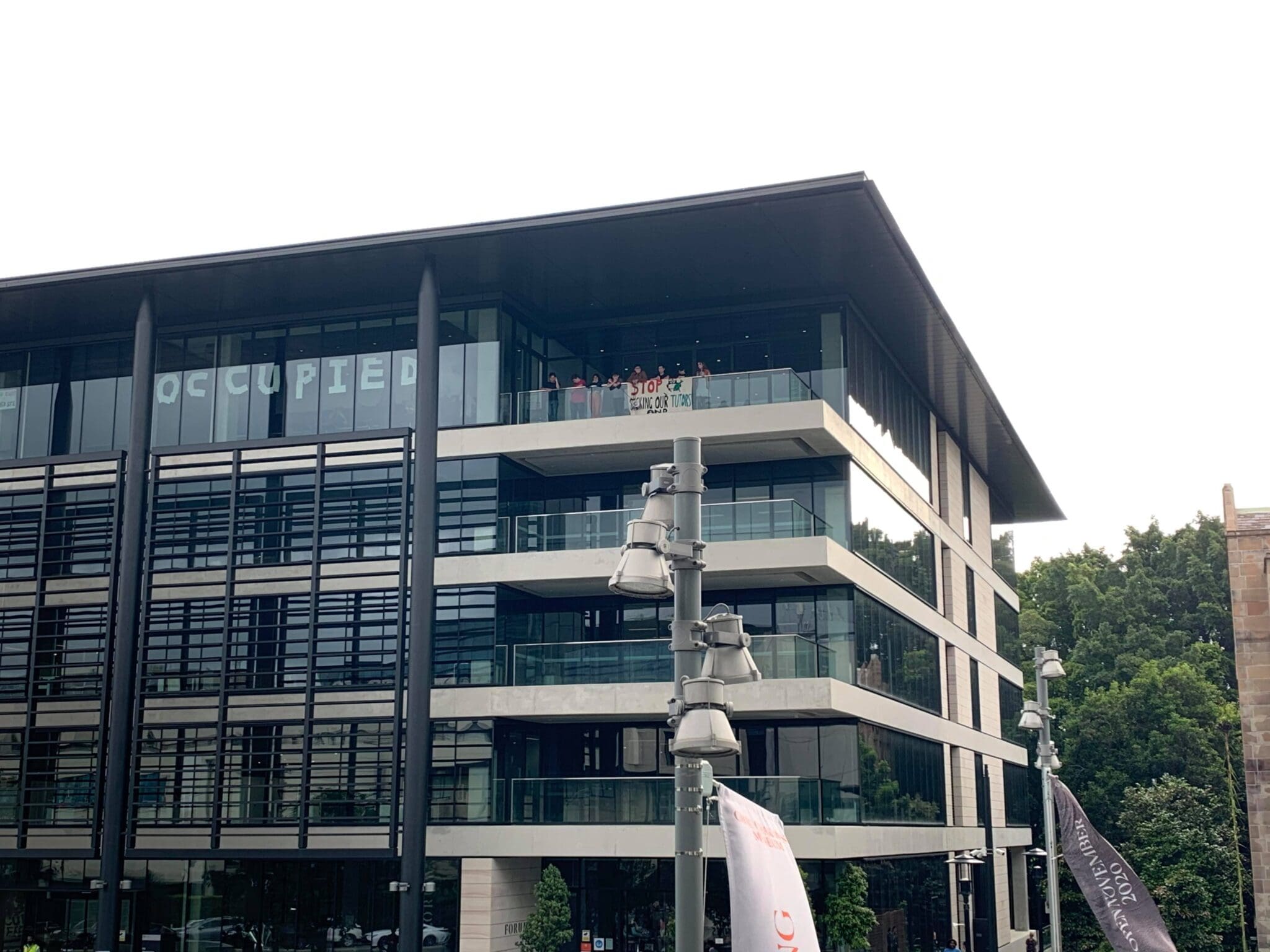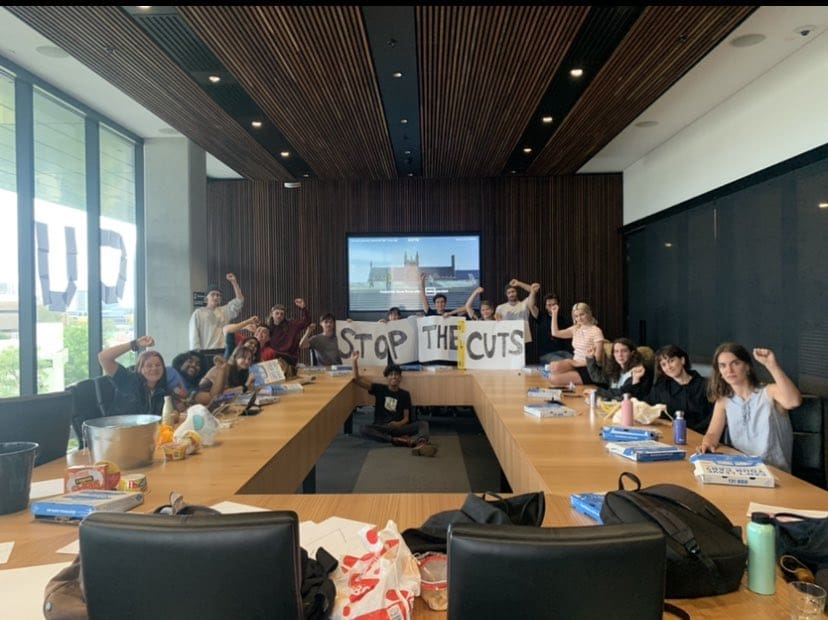With the NSW government announcing it would allow protests of up to 500 people, yesterday’s protest against education cuts was shaping up to be a quieter affair than previous campus rallies which have seen students and staff brutalised by police, and collectively fined to the tune of $54 thousand dollars under the Public Health Order.
Yet a Quad Lawns speak out called by the campus branch of the National Tertiary Education Union (NTEU) and chaired by member Alma Torlakovic soon transformed into something else altogether — a spontaneous occupation of the F23 University administration building.
NTEU Branch President Kurt Iveson spoke to the University’s $46million surplus on its 2020 budget, highlighting that the University is not facing financial difficulties. NSW Greens MLC Jenny Leong expressed her solidarity with students and staff and stressed that the Greens Party supported the fight against fee hikes and university managements pursuing austerity measures.
SRC Education Officer Jazzlyn Breen, who has been at the centre of organising recent rallies, addressed police repression from an eyewitness perspective. “I’ve seen fellow students and staff dragged across roads, pushed onto concrete, had their arms twisted and phones smashed all under the guise of covid.” Medical science student Oscar Chaffey critiqued decisions to cut large swathes of medical science staff during a pandemic, including the majority in pathology and over a third in physiology.
Following speeches, over a hundred chanting protesters marched to the administration building where casual staff member and PhD candidate in Political Economy, Joel Griggs addressed the crowd. Griggs specifically drew attention to the conditions of casual staff and research the recently established Casuals Network is conducting into wage theft. “For every dollar paid, management has stolen 65 cents,” Griggs explained. He also spoke concerningly about campus security’s collaboration with police in stifling recent protests as exposed by a recent freedom of information request.
Of course, the University’s relationship with police is not new. In 2013 Honi revealed emails between the University and police pointing to collaboration during the NTEU strikes which saw well documented police brutality. Indeed, then Newtown Police superintendent Simon Hardman would later become the head of campus security in 2017, a year where campus security entered the SRC and removed student posters promoting the NTEU’s strike action. Hardman was later found by a tribunal to be homophobic in his role at Newtown police and resigned as head of campus security earlier this year.
As the brief speakout outside F23 was beginning to wrap up, the electronic doors of the building, which are usually closed without a staff swipe access card, suddenly opened. Around 100 protesters immediately poured into the building, kicking off fiery chants against the education cuts.
Protesters made it to levels four and five, where senior management offices and conference rooms are, attempting to confront members of staff over the cuts to medical science jobs. Chants continued for over half an hour against not only the aforementioned cuts but also recent police presence on campus, with USyd Education Officer Jack Mansell delivering a speech to protesters on the stairs.
However, at around 2:45pm, Kurt Iveson attempted to dissuade student protesters from continuing to stay in the building as it had not been a previously discussed aspect of the rally, which the NTEU had originally put together. Moreover, roughly 70 student protesters either left the building of their own accord during this period, or began chanting and chasing far-right vlogger Chris “Chriscoveries” De Bruyne out of the building. De Bruyne has attended many recent protests, including gatecrashing and livestreaming a Black Lives Matter forum hosted by socialist group, Solidarity
The remaining 30 protesters then called an impromptu meeting, in which consensus was reached to stay and occupy the building, in particular levels four or five, for as long as possible with most keen to stay the night. Following this decision: a media release was quickly drafted and sent out, the Education Action Group created a Facebook event for those not occupying to express solidarity with protesters outside F23 at 5pm. Additionally, several students blocked two of the doors to the senior management office, in which Deputy Vice-Chancellor (Research) Duncan Ivison was still working.

From around 3:30pm, security workers in the building began preventing entry and exit of students and staff. However, a couple of students who had left early on into the occupation to get personal belongings managed to scheme a path up the elevators, bringing a few newcomers with them. Students then strategised to maximise visibility at 5pm, given that most staff would be leaving at that time, in addition to being able to communicate with protesters in support outside. At around 4:30pm, an unlocked management conference room was discovered on the top floor, adjacent to a large balcony that could be seen from Eastern Avenue and City Road.

Photo: Georgia Mantle
Simultaneously, a few student protesters realised that a meeting was occurring in one of the rooms on the top floor over Zoom with Senior Deputy Vice-Chancellor and potential future VC, Stephen Garton.
They entered and disrupted the conference call, chanting “no cuts, no fees” as those on the conference call with Garton exited the building.
Students also began delivering speeches from the balcony to those that had gathered in support below, with some on Eastern Avenue also speaking to the education cuts and expressing solidarity to those inside via megaphones. Lively chants and singing reverberated and could be heard from Fisher library.
“Michael Spence, Michael Spence, where are you, where are you? Come on out and face us, come on out and face us, shame on you, shame on you!”
“Whose university, our university!”
“Strike, occupy, shut it down! Burn the system to the ground!”
Close to 6pm, it became apparent that security workers in the building were preventing around 30 university staff members and two student protesters from leaving, holding them on the ground floor foyer. Roisin Murphy, one of the protesters who was stopped at the front entrance for over an hour, told Honi: “I requested that security allow me to leave multiple times, even noting that I’d co-operate with being escorted out by as many of them as they wish. I pleaded with them to the point of tears yet they continued to refuse.”
Amongst those remaining was Ivison, who students attempted to negotiate with. They argued that they had nothing to do with the staff being held back from going home, as that was a decision made by University security. Rather, they requested that Ivision, as a Deputy VC, reverse the cuts on medical science staff so that the occupation could end. However, Ivison outright denied the demands, and refused to talk to the occupiers again.
A looming issue for the protesters, who were still intending to stay overnight, was how to get food and other supplies into the building given that security were not allowing anyone to enter or exit. Initially, like something out of a straight-to-streaming thriller, protesters had tied together their jackets and outerwear end-to-end to form a makeshift rope, which they intended to hoist up items with.
However, just as the front doors of F23 opened to allow the two stranded student protesters out, around five from the crowd waiting outside managed to push past the line of security guards and into the ground floor foyer. Other protesters then threw additional food and bedding supplies over the security guards to those inside, who subsequently managed to make it to the top floor without getting stopped by security.
Around thirty police officers who were stationed in the area then formally came onto campus, escorting staff who had previously been unable to leave due to campus security’s shutdown of the building outside via various different exits, including the car park.
In light of police presence in the building, occupiers then called a meeting to discuss what the response would be. Consensus was reached to stay as long as possible, until a formal move-on order was issued.
Police then offered to negotiate with protesters inside the building, and a decision was made to send two representatives in an attempt to understand police motivation. The conversation with police was held in-between a set of glass doors such that the two protesters could rejoin the occupation and communicate with other students.
Police did not communicate an official move-on order, instead articulating that they had arrived because “the University revoked their consent for you to be here.” They told the two protesters that they had ten minutes to inform the rest of the group of this, adding that this was a chance for the group to leave peacefully, implying they would escalate the situation if students did not comply with that offer.
However, upon the representatives’ return to the boardroom, it was understood that the previous decision to stay until a move-on order had been given had somewhat shifted, in light of the view that there were not enough students to sustain the occupation and effectively resist police.
A decision was made to pack up and leave peacefully at 7.21pm. Chants of “bullshit, come off it, our education is not for profit” echoed in the building as protesters left via the stairs and joined supporters outside, celebrating what had been an over five hour occupation of a monument to managerialism.
The next protest against education cuts and to save medical science jobs is next Tuesday 3 November.





